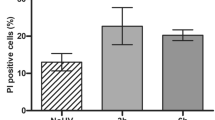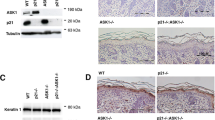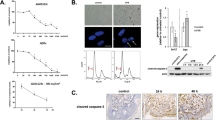Abstract
The epidermis must be protected against excess apoptotic cell death in response to ultraviolet-B (UV-B) irradiation. p53 is known to be critical for this protection. Although the p53 family member ΔNp51B/ΔNp63α (an N terminal-deleted form of p51/p63) is abundantly expressed in keratinocytes, its contribution to UV-B-dependent apoptosis is largely unknown. We found that, after a transient increase, ΔNp51B is downregulated in UV-B-irradiated keratinocytes undergoing apoptosis, whereas p53 is upregulated with delayed kinetics. Furthermore, the reduction of ΔNp51B by small interfering RNAs augmented UV-B-dependent apoptosis in keratinocytes, indicating that ΔNp51B blocks keratinocyte apoptosis. Although the exogenous expression of ΔNp51B in keratinocytes did not further block the UV-B-dependent apoptosis, to our surprise the expression of TAp51B (an isoform with a full NH2-terminal transactivation domain that is structurally and functionally similar to p53) decreased apoptosis significantly. The blockade of keratinocyte apoptosis by the p51 was dependent on the phosphorylation of Akt, resulting in the activation of a survival pathway. Thus, in addition to its indispensable roles in epithelial development, p51 acts in adult cells to protect the epidermis against UV-B irradiation by preventing excess depletion of keratinocytes.
This is a preview of subscription content, access via your institution
Access options
Subscribe to this journal
Receive 50 print issues and online access
$259.00 per year
only $5.18 per issue
Buy this article
- Purchase on Springer Link
- Instant access to full article PDF
Prices may be subject to local taxes which are calculated during checkout




Similar content being viewed by others
References
Bamberger C, Pollet D, Schmale H . (2002). Retinoic acid inhibits downregulation of DeltaNp63alpha expression during terminal differentiation of human primary keratinocytes. J Invest Dermatol 118: 133–138.
Brunner HG, Hamel BC, Van Bokhoven H . (2002). The p63 gene in EEC and other syndromes. J Med Genet 39: 377–381.
Chen WS, Xu PZ, Gottlob K, Chen ML, Sokol K, Shiyanova T et al. (2001). Growth retardation and increased apoptosis in mice with homozygous disruption of the Akt1 gene. Genes Dev 15: 2203–2208.
Cui R, He J, Mei R, de Fromentel CC, Martel-Planche G, Taniere P et al. (2005). Expression of p53, p63, and p73 isoforms in squamous cell carcinoma and adenocarcinoma of esophagus. Biochem Biophys Res Commun: (Epub ahead of print).
Dohn M, Zhang S, Chen X . (2001). p63alpha and DeltaNp63alpha can induce cell cycle arrest and apoptosis and differentially regulate p53 target genes. Oncogene 20: 3193–3205.
Greer EL, Brunet A . (2005). FOXO transcription factors at the interface between longevity and tumor suppression. Oncogene 24: 7410–7425.
Jiang W, Ananthaswamy HN, Muller HK, Kripke ML . (1999). p53 protects against skin cancer induction by UV-B radiation. Oncogene 18: 4247–4253.
Keyes WM, Wu Y, Vogel H, Guo X, Lowe SW, Mills AA . (2005). p63 deficiency activates a program of cellular senescence and leads to accelerated aging. Genes Dev 19: 1986–1999.
Koster MI, Lu SL, White LD, Wang XJ, Roop DR . (2006). Reactivation of developmentally expressed p63 isoforms predisposes to tumor development and progression. Cancer Res 66: 3981–3986.
Kraemer KH . (1997). Sunlight and skin cancer: another link revealed. Proc Natl Acad Sci USA 94: 11–14.
Liefer KM, Koster MI, Wang XJ, Yang A, McKeon F, Roop DR . (2000). Down-regulation of p63 is required for epidermal UV-B-induced apoptosis. Cancer Res 60: 4016–4020.
Mills AA . (2006). p63: oncogene or tumor suppressor? Curr Opin Genet Dev 16: 38–44.
Mills AA, Zheng B, Wang XJ, Vogel H, Roop DR, Bradley A . (1999). p63 is a p53 homologue required for limb and epidermal morphogenesis. Nature 398: 708–713.
Okuyama R, Nguyen BC, Talora C, Ogawa E, Tommasi di Vignano A, Lioumi M et al. (2004). High commitment of embryonic keratinocytes to terminal differentiation through a Notch1-caspase 3 regulatory mechanism. Dev Cell 6: 551–562.
Okuyama R, Ogawa E, Nagoshi H, Yabuki M, Kurihara A, Terui T et al. (2007). p53 homologue, p51/p63, maintains the immaturity of keratinocyte stem cells by inhibiting Notch1 activity. Oncogene 26: 4478–4488.
Osada M, Ohba M, Kawahara C, Ishioka C, Kanamaru R, Katoh I et al. (1998). Cloning and functional analysis of human p51, which structurally and functionally resembles p53. Nat Med 4: 839–843.
Papoutsaki M, Moretti F, Lanza M, Marinari B, Sartorelli V, Guerrini L et al. (2005). A p38-dependent pathway regulates DeltaNp63 DNA binding to p53-dependent promoters in UV-induced apoptosis of keratinocytes. Oncogene 24: 6970–6975.
Ratovitski EA, Patturajan M, Hibi K, Trink B, Yamaguchi K, Sidransky D . (2001). p53 associates with and targets Delta Np63 into a protein degradation pathway. Proc Natl Acad Sci USA 98: 1817–1822.
Stambolic V, MacPherson D, Sas D, Lin Y, Snow B, Jang Y et al. (2001). Regulation of PTEN transcription by p53. Mol Cell 8: 317–325.
Thrash BR, Menges CW, Pierce RH, McCance DJ . (2006). AKT1 provides an essential survival signal required for differentiation and stratification on primary human keratinocytes. J Biol Chem 281: 12155–12162.
Waltermann A, Kartasheva NN, Dobbelstein M . (2003). Differential regulation of p63 and p73 expression. Oncogene 22: 5686–5693.
Wang HQ, Quan T, He T, Franke TF, Voorhees JJ, Fisher GJ . (2003). Epidermal growth factor receptor-dependent, NF-kappaB-independent activation of the phosphatidylinositol 3-kinase/Akt pathway inhibits ultraviolet irradiation-induced caspases-3, -8, and -9 in human keratinocytes. J Biol Chem 278: 45737–45745.
Westfall MD, Joyner AS, Barbieri CE, Livingstone M, Pietenpol JA . (2005). Ultraviolet radiation induces phosphorylation and ubiquitin-mediated degradation of DeltaNp63alpha. Cell Cycle 4: 710–716.
Yang A, Kaghad M, Wang Y, Gillett E, Fleming MD, Dotsch V et al. (1998). p63, a p53 homolog at 3q27–29, encodes multiple products with transactivating, death-inducing, and dominant-negative activities. Mol Cell 2: 305–316.
Yang A, Schweitzer R, Sun D, Kaghad M, Walker N, Bronson RT et al. (1999). p63 is essential for regenerative proliferation in limb, craniofacial and epithelial development. Nature 398: 714–718.
Ziegler A, Jonason AS, Leffell DJ, Simon JA, Sharma HW, Kimmelman J et al. (1994). Sunburn and p53 in the onset of skin cancer. Nature 372: 773–776.
Acknowledgements
This study was partly supported by a Grant in Aid from the Ministry of Education, Culture, Sports, Science, and Technology of the Japanese government.
Author information
Authors and Affiliations
Corresponding author
Rights and permissions
About this article
Cite this article
Ogawa, E., Okuyama, R., Ikawa, S. et al. p51/p63 inhibits ultraviolet B-induced apoptosis via Akt activation. Oncogene 27, 848–856 (2008). https://doi.org/10.1038/sj.onc.1210682
Received:
Revised:
Accepted:
Published:
Issue Date:
DOI: https://doi.org/10.1038/sj.onc.1210682
Keywords
This article is cited by
-
ΔNp63 targets cytoglobin to inhibit oxidative stress-induced apoptosis in keratinocytes and lung cancer
Oncogene (2016)
-
1α, 25-Dihydroxyvitamin D3 and the vitamin D receptor regulates ΔNp63α levels and keratinocyte proliferation
Cell Death & Disease (2015)
-
Epidermal FABP (FABP5) Regulates Keratinocyte Differentiation by 13(S)-HODE-Mediated Activation of the NF-κB Signaling Pathway
Journal of Investigative Dermatology (2011)
-
ΔNp63α regulates keratinocyte proliferation by controlling PTEN expression and localization
Cell Death & Differentiation (2011)
-
p63 regulates the caspase-8-FLIP apoptotic pathway in epidermis
Cell Death & Differentiation (2009)



